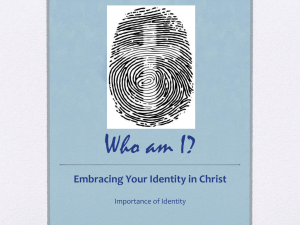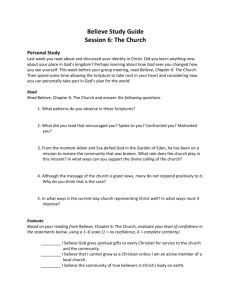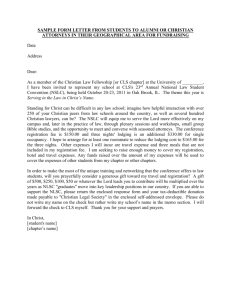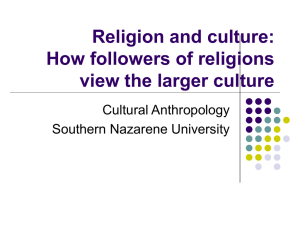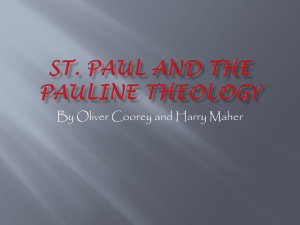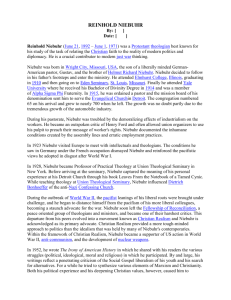Our God is the Lord of the Dance for Women Too Comments on
advertisement
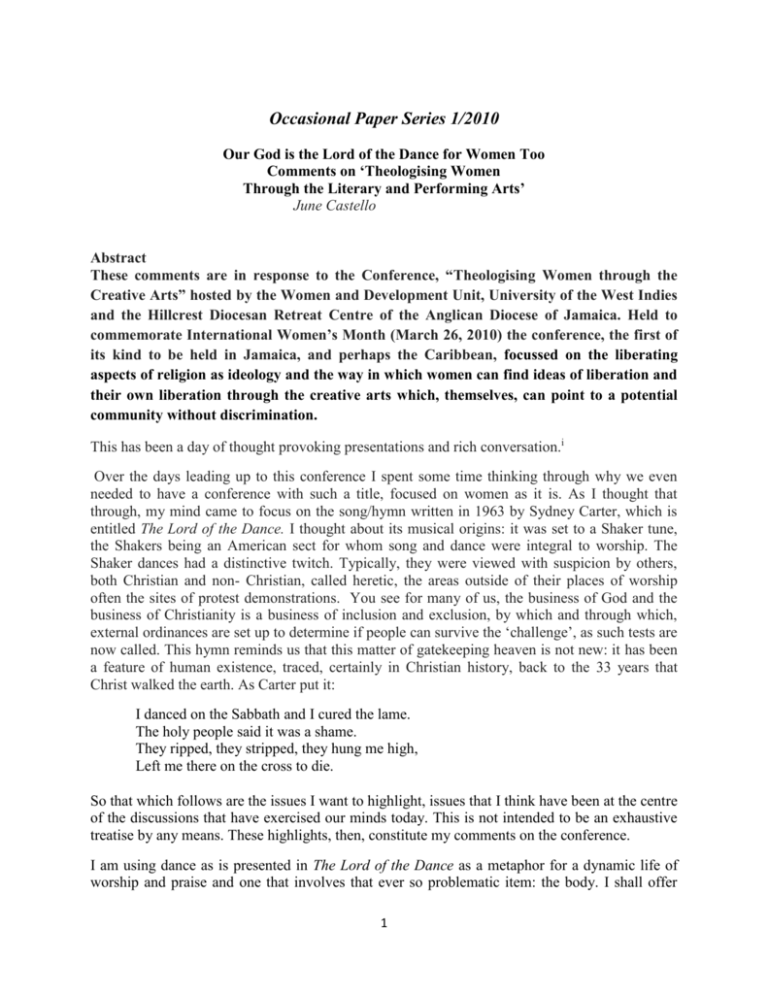
Occasional Paper Series 1/2010 Our God is the Lord of the Dance for Women Too Comments on ‘Theologising Women Through the Literary and Performing Arts’ June Castello Abstract These comments are in response to the Conference, “Theologising Women through the Creative Arts” hosted by the Women and Development Unit, University of the West Indies and the Hillcrest Diocesan Retreat Centre of the Anglican Diocese of Jamaica. Held to commemorate International Women’s Month (March 26, 2010) the conference, the first of its kind to be held in Jamaica, and perhaps the Caribbean, focussed on the liberating aspects of religion as ideology and the way in which women can find ideas of liberation and their own liberation through the creative arts which, themselves, can point to a potential community without discrimination. This has been a day of thought provoking presentations and rich conversation.i Over the days leading up to this conference I spent some time thinking through why we even needed to have a conference with such a title, focused on women as it is. As I thought that through, my mind came to focus on the song/hymn written in 1963 by Sydney Carter, which is entitled The Lord of the Dance. I thought about its musical origins: it was set to a Shaker tune, the Shakers being an American sect for whom song and dance were integral to worship. The Shaker dances had a distinctive twitch. Typically, they were viewed with suspicion by others, both Christian and non- Christian, called heretic, the areas outside of their places of worship often the sites of protest demonstrations. You see for many of us, the business of God and the business of Christianity is a business of inclusion and exclusion, by which and through which, external ordinances are set up to determine if people can survive the ‘challenge’, as such tests are now called. This hymn reminds us that this matter of gatekeeping heaven is not new: it has been a feature of human existence, traced, certainly in Christian history, back to the 33 years that Christ walked the earth. As Carter put it: I danced on the Sabbath and I cured the lame. The holy people said it was a shame. They ripped, they stripped, they hung me high, Left me there on the cross to die. So that which follows are the issues I want to highlight, issues that I think have been at the centre of the discussions that have exercised our minds today. This is not intended to be an exhaustive treatise by any means. These highlights, then, constitute my comments on the conference. I am using dance as is presented in The Lord of the Dance as a metaphor for a dynamic life of worship and praise and one that involves that ever so problematic item: the body. I shall offer 1 comments on the tensions between the Christian church and culture in general, and the performing arts in particular, on body politics and the questions that I recommend to guide our future consideration of these issues. For so long, women have not been considered – if we look at philosophy and all of the derived disciplines – to be worthy of being either agents or positive subjects of a study of God (theology). They were usually treated as ‘missiological objects of Christian mission’ (Kwok-PuiLan, 1989) and so much of women’s history, feminist history and feminist theology has been an attempt to set the record right. These academic projects have sought to re-state and, in some cases, reveal the fact that women are, created like men, in the image of God. In fact, for many years, the focus of Christian feminist theology has been just that: women being created in the imago dei. So, here comes this conference that re-affirms the right and capacity of women to be part of the study of God and the divine. The title of the conference also brought to the forefront of my mind the matter of theologising and the struggle over who has such a right to render a matter theological or to view something from the viewpoint of theology, which is the study of the divine or God. Can those who are not trained theologians or ordained ministers of the gospel know enough to theologise? Can women theologise? And, are the literary and performing arts worthy subjects for theological study? In this conference, the focus on women as equal creations of God is joined with three areas which many moral Christians feel exist outside of the Church but are still to be governed by church values and standards: the creative arts; music; dance. Is such rebellion or is it resistance? The union of these (seemingly) disparate and contentious issues forces us into a consideration of culture. What, if any, is the relationship between Christ and culture? How does the Church, through its agents, examine and offer public guidance on what the society does in the light of the Word of Christ? (Castello, 2006). Raymond Williams as cited in Storey (1993) has, wisely, commented that this word, ‘culture’ is ‘one of the two or three most complicated words in the English language and defines it as “the general process of intellectual, spiritual and aesthetic development”; “a particular way of life whether of a people, a period, group” and “the works and practices of intellectual and especially artistic activity”. From all of those interpretations we see that Christ and Christianity have a relationship with culture. A reading of the history of the early Christian Church would reveal that by the end of the period known as Antiquity, the Faith, as it was carried and practised by the early Christians, had transformed from within the cultures of the various communities and this was seen in art, architecture, music, institutions such as the academy and in everyday patterns of life. Yet, today, we argue that there is a crisis of culture which is exemplified in the music, dress, language, sexual practices of our people (Castello, 2006). Much of this crisis is defined by the seeming glorification of the common, the vulgar, assumed to be the culture of the working class masses. The perception of the crisis is, further by the reality, that much of the music, dance that we see in and out of the church has been the creation of working class artistes. But, our concerns in this area are far from novel. Writing in 1913, Gresham Machen made the critical observation that one of the greatest problems to have agitated the Church is the problematic relationship between ‘knowledge and piety, between culture and Christianity’. Machen traces the history of this problem between what he describes as two tendencies present 2 in the church: the scientific or academic tendency and the practical tendency. According to Machen, the former is represented by persons who have focused on forming proper conceptions and understandings of Christianity, its facts, symbols and its foundations and the matter of ‘practical consequences’ is of little concern. The latter tendency is represented by persons who focus on the simplicity of the good news and the plight of a world languishing unto death in sin. So, there is an urgency expressed by these persons to preach the Word in and out of season and less attention paid to the religious facts, symbols and foundations. They are more concerned that there should be faith with works. As Machen explains this, there seems to be an irreconcilable tension between the practice of Christian faith and the knowledge of Christianity; the scientific spirit of formal theology and the practice of simple an unquestioning faith. Writing four decades after Machen, Richard Niebuhr (1951) dedicates an entire text to the matter of Christ and culture. He identifies five positions that are taken by various advocates on this matter. Those who adopt the "Christ against culture" position reject culture as fallen, and require separation from it as a criterion for absolute loyalty to Christ. In contrast the "Christ of culture" type finds in Christ an affirmation of all that is good in culture. So, there is no inherent contradiction and conflict. This type sees little or no difference between loyalty to Christ and the best a particular culture has to offer. Then there is the "Christ above culture" type which seeks a synthesis of culture with Christ so that grace is the architect that perfects or builds upon culture. This type sees that the good in culture needs to be and can be properly ordered, fulfilled and finished by Christ. The "Christ and culture in paradox" type points the disruptions between culture and the Christian life. So it is important to keep a critical distance from culture, but those who subscribe to this interpretation concede that culture can be useful in the Christian life once it is kept within its appropriate bounds. For this type, culture has a legitimate place in Christian life, but the Christian’s heart and the church must be ruled by Christ. Niebuhr’s final type is "Christ transforming culture". This type offers a critique of culture but also enters into alliance with elements of culture that are capable of becoming part of ongoing work toward the kingdom of God. So, here culture becomes the raw material that can be shaped by Christians into the Christian vision of human life. The first presentation we had today fits, in my opinion, into the final type. Charlene Plummer, Christian and trained dancer, put the group of women through their paces. The focus was on using the body as an instrument of praise and worship, always with the focus on God. This session required us to divest ourselves of our self-consciousness and deliberately communicate with God how we felt about Him. Dance was presented not as body movements for the sake of the beauty of movement but as a language with grammars and lexicon. Once these grammars are recognised and we focus on God then we can communicate to Him and about Him. The discussion around this session brought to the fore our collective and varied concerns about how to communicate the message of the gospel in church spaces and, at the same time, navigate the distracting paths that lead to a focus on the appropriate presentations of the body. This primary focus on appropriate presentations of the body comes from a culture’s interpretations and is not necessarily grounded in the teachings of the Christian Bible. Earlier, I described the body as a problematic thing. It is very symbolic in human culture and is the means through which the person and the community express themselves. The body is also the 3 medium that others use to read what is in people’s minds, hearts and souls. Its status, however, within dominant Western intellectual tradition has not been high (Shildrick & Price, 1999). It has been dismissed as an impediment to theorising and has been evacuated from intellectual discussions. Western philosophical traditions have set it within a dyad with the mind. Typically, within this dyad, mind is the valued component and this, Shildrick and Price (1999) argue, is the reflection of “a transhistorical desire to access the pure Intelligible as the highest form of Being.” So, the body seems to exist outside of intelligence and within the realm of the emotions. To be located within the realm of emotions in the context of Western philosophy is to be irrational, unpredictable and even disruptive. In spite of this the body is such a central part of our lives for worship and every other part of our existence. Even as we live in a world where scientific and medical alterations of the body can be accomplished, it is, in many ways, all we have for ourselves. Christian theology has always had an embodied theology, according to Lisa Isherwood and Elisabeth Stuart (2000), one that is rooted in creation, incarnation, resurrection and sacrament. Yet even within Christian theology there has been some discomfort with the body. The Apostle Paul’s suspicion of the human body is perhaps best expressed by these passages from the book of Romans 8:5-8 (King James Version) For they that are after the flesh do mind the things of the flesh: but they that are after the Spirit the things of the Spirit. For to be carnally minded is death; but to be spiritually minded is life and peace. Because the carnal mind is enmity against God for it is not subject to the law of God, neither indeed can be. So then, they that are in the flesh cannot please God. The second passage, Romans 6, 12-13, reads thus: Let not sin therefore reign in your mortal body, that ye should obey it in the lusts thereof. Neither yield ye your members as instruments of unrighteousness unto sin but yield yourselves unto God, as those that are alive from the dead, and your members as instruments of righteousness unto God. These lines from Paul are often used in what Anthony Pinn (2004) describes as the “flood of theological rhetoric and ritualized distrust of the body”ii. Pinn criticized the Black Christian Church for the fact that while most forms of Black Christianity are built on the assumptions of the presence of divinity in flesh, this has not translated into a theology that embraces the worshipper’s physical body and the full range of pleasures it can give and receive. This seems to be the sentiment of many Christians, non-Christians and church adherents in our society, if the tone and substance of popular discussions here in Jamaica are to be taken at face value. Pinn describes such a theology of the body as ‘philosophically constipated’. So how does this connect in my mind to women? Feminists have tracked the ways in which women have been contained and constrained in bodies that in disciplinary discourses have been rendered “frail, imperfect, unruly, and unreliable, subject to various intrusions which are not under conscious control.”iii Women are often characterised by their reproductive powers and sexuality which, while being seen as special, have become the basis upon which women have been understood to be vulnerable and in need of special protection (Grosz, 1994). In the 4 mind/body cross-pairing, according to Grosz, mind is associated with men and masculinity and the body, with women and femininity. Women’s bodies, then, Grosz asserts, are often understood as possessing a ‘natural inequality’, based upon the notion that there is a universal measure with which bodies can be assessed outside of the specificity of biological sex. It seems to me that many of the fears and discomforts that we have with the body are really fears and discomforts we have with women and with women’s bodies. The presentation by Ms. Norma Walters, music educator, was focused on “Theologising Women through Music”. Again, the point was made that women and men are created in the image of God but the Church has not fully understood itself so it cannot produce a sufficient theology of women, the poor or anyone else. Ms. Walters looked at the content of hymn and the ways in which the lyrics spoke beautifully of the wonders of God’s creation and His love for all. This session seemed to fall into Niebuhr’s ‘Christ of culture’ type as the beauty of the music and the lyrics were directly connected to all that Christ represents. In the third session we were read ‘Jah is My Shepherdess’, a beautiful re-working of the 23rd Psalm by Ife Harris. Ife Harris’ Psalm both made God very personal to her as a woman and disrupted the comfortable notion of God as exclusively masculine. In this poem, there was the reaffirmation of women in the image of God and this session, too, seemed to fit into the Christ of culture framework. Of course, for both music and literature, there is the ongoing struggle for acceptance as suitable vehicles for Christian study and worship. At the end of the sessions there were some questions that emerged in my mind as issues for serious consideration in our churches. The questions are as follows: 1. How do women feature in the discussion around culture and Christ? 2. How ought the church to treat with culture? 3. What does the Lord will for women and what does it mean for them to be made in His image? 4. How has the gender system limited us as women in achieving the levels of spirituality and closeness to Him that he desires? As we seek to find answers to these questions, our hope is that we will never lose focus on God’s big plan for His people especially since it is a plan that is bigger than the divisions of nationality, race, class and gender. It is my hope that we will recognise that in all we do that culture transformed by Christ is illuminating, energising and redemptive. In the words of the songwriter, Brendan Graham: You raise me up so I can stand on mountains; You raise me up to walk on stormy seas. I can be strong when I am on your shoulder. You raise me up to more than I can be. Eventually may we recognise that since Christ has a relationship with culture and that he transforms culture, we have the freedom and confidence to worship and to sing like the Shakers: 5 Dance, dance, wherever you may be I am the lord of the dance, said he And I lead you all, wherever you may be And I lead you all in the dance, said he. He is, after all, the Lord of the Dance who is the life that will never, never die. References Castello, J. (2006). “Public Theology Today: Faith and Culture Revisited.” Paper presented at public forum held at the Portmore Missionary Church, St. Catherine Jamaica. Gathje, P. (2002). “A Contested Classic: Critics ask: Whose Christ? Which culture?” Christian Century. June 19-26. Grosz, Elizabeth. (1994). Volatile bodies: Toward a Corporeal Feminism.Australia, Allen and Unwin. Isherwood, Lisa & Elizabeth Stuart. (1988). Introducing Body Theology. England, Sheffield: Academic Press. Machen, G. (1913). “Christianity and Culture, The Princeton Theological Review, Vol. 11. Niebuhr, H.R. (1975). Christ and Culture. New York, NY: Harper and Row Publishers. Pinn, A. & D. Hopkins. (2004). “Introduction”, in Pinn, A. & Hopkins, D. (Eds) Loving the Body: Black Religious Studies and the Erotic. New York, NY: Palgrave Macmillan, 2004. Puil-Lan, K. In J. Plaskow& C. Christ, (eds). (1989). Weaving the Visions: New Patterns in Feminist Spirituality, New York, NY: HarperCollins. Shildrick, M. & J. Price. (1999). “Openings on the Body: A Critical Introduction in J. Price, and M. Shidrick (eds) Feminist Theory and the Body. New York, NY: Routledge. Storey, J. (1993). An Introductory Guide to Cultural Theory and Popular Culture. Athens, GA: University of Georgia Press. 6 Notes i Note that the conference proceedings will be produced on DVD. Introduction. In Pinn, A. &Hopkins, D.(eds) Loving the Body: Black Religious Studies and the Erotic, (.New York, NY: Palgrave Macmillan, 2004 ) pp. 3. iii Introduction in Grosz, E. Volatile Bodies: Toward a Corporeal Feminism, (Bloomington, IN: Indiana University Press, 1994), pp .13. ii 7


